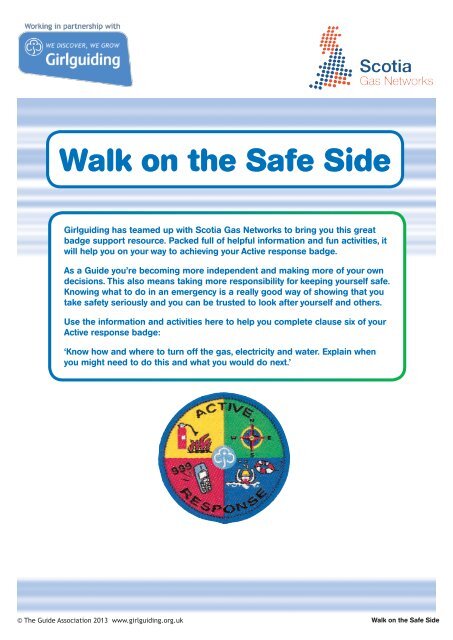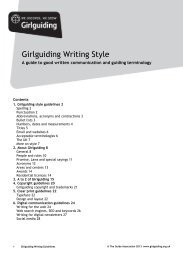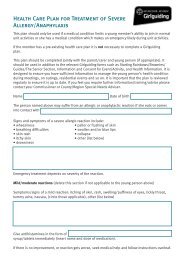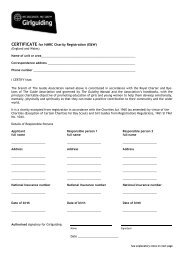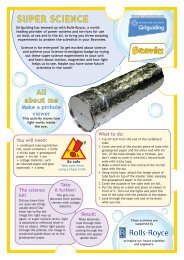Walk on the Safe Side - Girlguiding UK
Walk on the Safe Side - Girlguiding UK
Walk on the Safe Side - Girlguiding UK
Create successful ePaper yourself
Turn your PDF publications into a flip-book with our unique Google optimized e-Paper software.
<str<strong>on</strong>g>Walk</str<strong>on</strong>g> <strong>on</strong> <strong>the</strong> <strong>Safe</strong> <strong>Side</strong><strong>Girlguiding</strong> has teamed up with Scotia Gas Networks to bring you this greatbadge support resource. Packed full of helpful informati<strong>on</strong> and fun activities, itwill help you <strong>on</strong> your way to achieving your Active resp<strong>on</strong>se badge.As a Guide you’re becoming more independent and making more of your owndecisi<strong>on</strong>s. This also means taking more resp<strong>on</strong>sibility for keeping yourself safe.Knowing what to do in an emergency is a really good way of showing that youtake safety seriously and you can be trusted to look after yourself and o<strong>the</strong>rs.Use <strong>the</strong> informati<strong>on</strong> and activities here to help you complete clause six of yourActive resp<strong>on</strong>se badge:‘Know how and where to turn off <strong>the</strong> gas, electricity and water. Explain whenyou might need to do this and what you would do next.’© The Guide Associati<strong>on</strong> 2013 www.girlguiding.org.uk <str<strong>on</strong>g>Walk</str<strong>on</strong>g> <strong>on</strong> <strong>the</strong> <strong>Safe</strong> <strong>Side</strong>
Part 1: The factsRead <strong>the</strong> facts about <strong>the</strong> dangers of gas, electricity and water in buildings.Then do <strong>the</strong> ‘Switch off!’ activity <strong>on</strong> page 4.Gas: What a stink!Natural gas is a source of power for things like cookersor heating and hot water systems. It is a ‘fossil fuel’created under <strong>the</strong> ground when dead plants andanimals decay. Natural gas doesn’t smell of anything,but gas companies add a horrible smell to it so that ifyou have a leak in your home, you will know at <strong>on</strong>ce!Why is it dangerous?Gas can ignite (catch fire) very easily,so if leaking gas comes into c<strong>on</strong>tactwith a flame or spark, it can start a fire.How do we keep safe?If you smell gas, follow <strong>the</strong>se top tips.Do Turn off <strong>the</strong> gas supply, if you know where <strong>the</strong> gas meter is (see ‘Switch off! <strong>on</strong> page 4). Make sure any gas appliances are turned off. If <strong>the</strong>re is a smell inside <strong>the</strong> building, open windows and doors to get rid of <strong>the</strong> gas. Call <strong>the</strong> Nati<strong>on</strong>al Gas Emergency Number <strong>on</strong> 0800 111 999. This is an all-year-round,24-hour number.D<strong>on</strong>’t Go looking for <strong>the</strong> gas meter if you d<strong>on</strong>’t know where it is. Operate any electrical switches. Turning a switch <strong>on</strong> or off could ignite escaping gas. Enter a cellar if you smell gas, even if <strong>the</strong> gas meter is located in <strong>the</strong> cellar. Smoke or use any naked flames.Electricity: What’s <strong>the</strong> buzz?Electricity is a kind of energy that powers lots ofthings around our homes. Think about all <strong>the</strong>electricity you have used today, or even just in yourmeeting. Did you watch TV, turn <strong>on</strong> <strong>the</strong> lights, use<strong>the</strong> toaster or play a computer game?Why is it dangerous?Electricity travels al<strong>on</strong>g wires andcables, but it can also travel throughpeople. If it goes through your bodyit could give you a burn or anelectric shock. A mild electric shockwill feel tingly and make you jump,but a severe <strong>on</strong>e can stop <strong>the</strong> heartand cause death. Electricity canalso start fires if not used safely.© The Guide Associati<strong>on</strong> 2013 www.girlguiding.org.uk <str<strong>on</strong>g>Walk</str<strong>on</strong>g> <strong>on</strong> <strong>the</strong> <strong>Safe</strong> <strong>Side</strong>2
How do we keep safe?These tips will help you to use electricity safely.Do Always unplug your charger from <strong>the</strong> socket after you’ve finished charging yourmobile ph<strong>on</strong>e, MP3 player or hair straightener. This will reduce <strong>the</strong> risk of fire.D<strong>on</strong>’t Plug too many appliances into <strong>the</strong> same socket – it can get too hot and maycause a fire. Stick anything into <strong>the</strong> holes of a socket, o<strong>the</strong>r than a plug of course! Use a plug if you can see <strong>the</strong> wires or scorch marks – this plug is faulty andwill need to be replaced. Touch some<strong>on</strong>e who has had an electric shock because you might get <strong>on</strong>etoo. Get help right away by calling 999. Mix electricity and water - <strong>the</strong>y are not friends! This includes not usingelectrical equipment when your hands are wet; you could get an electric shock. Touch or use any pole to make c<strong>on</strong>tact with overhead wires or cables exposedin <strong>the</strong> ground. Enter an electricity substati<strong>on</strong> or any building or area displaying ‘DangerElectricity’ signs (<strong>the</strong>se will be yellow signs with black writing).Water: D<strong>on</strong>’t be a drip!Water comes into buildings through pipes,and can be stored in tanks. A leaky pipe ortank can cause an indoor flood.How do we keep safe?If <strong>the</strong>re is a water leak...Do Turn off <strong>the</strong> water supply at <strong>the</strong> stopvalve (see ‘Switch off!’ <strong>on</strong> page 4). Call a plumber.D<strong>on</strong>’t Touch any electrical switches near<strong>the</strong> leak.Why is it dangerous?A water leak in a building cancause damage to <strong>the</strong> buildingitself and <strong>the</strong> things inside. Aserious leak could put people atrisk, for example from a ceilingcollapsing or even fromdrowning. However, even a smallleak must be stoppedimmediately in case water leaksinto <strong>the</strong> electrical system. Watercould complete an electricalcircuit, causing danger from firesor electric shocks.© The Guide Associati<strong>on</strong> 2013 www.girlguiding.org.uk <str<strong>on</strong>g>Walk</str<strong>on</strong>g> <strong>on</strong> <strong>the</strong> <strong>Safe</strong> <strong>Side</strong>3
Switch off!In an emergency, such as a gas leak, a water leakor an electrical problem, you may need to turn off<strong>the</strong> power or water supply to <strong>the</strong> building. Knowinghow to do this is a great way to keep yourselvessafe, at home or in your meeting place.You will need• Paper and pens• An adult to help you find <strong>the</strong> waterand power suppliesWhat to do1. Draw a plan of your meeting place. Show <strong>the</strong> different rooms and <strong>the</strong> doorsand windows.2. Ask your Leader to show you where to turn off <strong>the</strong> gas, electricity and watersupplies to <strong>the</strong> building. Mark <strong>the</strong>se <strong>on</strong> your plan. If <strong>the</strong>re is room, add notes abouthow to turn off <strong>the</strong> supplies.Gas: The gas meter may be inside <strong>the</strong> building or in a box outside. There will bea handle <strong>on</strong> <strong>the</strong> pipe near <strong>the</strong> meter; turn this handle a quarter turn in ei<strong>the</strong>rdirecti<strong>on</strong> to shut <strong>the</strong> gas supply off.Electricity: The electrical power panel is a box which c<strong>on</strong>tains switches that canturn <strong>the</strong> electricity supply to <strong>the</strong> building <strong>on</strong> or off. To switch it off, flip <strong>the</strong> levercalled ‘Main’ to <strong>the</strong> ‘Off’ positi<strong>on</strong>. This will cut <strong>the</strong> electricity supply to all <strong>the</strong> o<strong>the</strong>rcircuits, turning it off in <strong>the</strong> whole building.Water: The stop valve for <strong>the</strong> water supply is usually located under <strong>the</strong> kitchensink, in an airing cupboard or sometimes under <strong>the</strong> floorboards near <strong>the</strong> fr<strong>on</strong>tdoor. To turn off <strong>the</strong> water flow, turn <strong>the</strong> lever clockwise. It will take a couple ofminutes before <strong>the</strong> flow stops completely.3. If you like, you can add some more informati<strong>on</strong> about safety and maybe someemergency c<strong>on</strong>tact numbers (see page 7). Put <strong>the</strong> plan up <strong>on</strong> a wall where any<strong>on</strong>ewho uses <strong>the</strong> building can see it.4. Now, each draw a plan of your home. When you get home, ask an adult to show youwhere to turn off <strong>the</strong> energy and water supplies. Mark <strong>the</strong>m <strong>on</strong> <strong>the</strong> plan in <strong>the</strong> sameway as you did for your meeting place. Keep it somewhere handy for every<strong>on</strong>e in yourhome to use.UpGas MeterPantryMeetingroomElectrical PanelWater Stop ValveWindowsKitchenSeatingareaDiningareaHallFr<strong>on</strong>tdoorPorchW/C4© The Guide Associati<strong>on</strong> 2013 www.girlguiding.org.uk <str<strong>on</strong>g>Walk</str<strong>on</strong>g> <strong>on</strong> <strong>the</strong> <strong>Safe</strong> <strong>Side</strong>
Part 2: Carb<strong>on</strong> m<strong>on</strong>oxideIt’s really important to know about <strong>the</strong> dangers of ano<strong>the</strong>r gas,carb<strong>on</strong> m<strong>on</strong>oxide. Read <strong>the</strong> facts and have a go at <strong>the</strong> activity.Carb<strong>on</strong> m<strong>on</strong>oxide:The silent killerCarb<strong>on</strong> m<strong>on</strong>oxide can be releasedfrom fossil fuel burning appliances(like stoves, fires, boilers, cookers orwater heaters) which haven’t beenfitted properly, are badly repaired orpoorly maintained, or have blockedchimneys or vents. It can also beproduced in camping envir<strong>on</strong>ments,around fires, lamps, lanterns,barbecues or in o<strong>the</strong>r situati<strong>on</strong>swhere gas, oil, wood etc are burned.Why is it dangerous?Carb<strong>on</strong> m<strong>on</strong>oxide (or CO) is called <strong>the</strong> ‘silent killer’: it hasno smell, no taste and no colour, but it is very pois<strong>on</strong>ous.All <strong>the</strong>se factors make it a very sneaky and dangerous gaswhich can kill without warning.• Around 40 people in <strong>the</strong> <strong>UK</strong> die every year fromcarb<strong>on</strong> m<strong>on</strong>oxide pois<strong>on</strong>ing.• Hundreds more suffer ill-effects including tiredness,dizziness, headaches and feeling sick.• Elderly and young people are at higher risk thanhealthy adults.CO-Gas <strong>Safe</strong>ty, 2012: www.co-gassafety.co.uk/index.htmlHow do we keep safe?Find out where <strong>the</strong> gas appliances are in your meeting place,or at home. These should be checked each year by a Gas<strong>Safe</strong> registered engineer, who will also make sure that ventsare clear from blockages. A carb<strong>on</strong> m<strong>on</strong>oxide detector shouldbe fitted and tested regularly. Find out who organises <strong>the</strong>setests in your meeting place or at home and remind <strong>the</strong>m to get<strong>the</strong> test carried out for this year if it hasn’t already been d<strong>on</strong>e.CO campaignYou will need• Smartph<strong>on</strong>e or video camera (opti<strong>on</strong>al)What to doThere is still little awareness about <strong>the</strong> dangers of carb<strong>on</strong>m<strong>on</strong>oxide. As a unit you can spread <strong>the</strong> word about this ‘silentkiller’ and help o<strong>the</strong>rs understand how to protect <strong>the</strong>mselves in<strong>the</strong>ir homes and meeting places.Design a TV advert that tells people about <strong>the</strong> dangers of carb<strong>on</strong>m<strong>on</strong>oxide gas and <strong>the</strong> steps <strong>the</strong>y can take to protect <strong>the</strong>mselvesand <strong>the</strong>ir families. Maybe you can act out your idea for <strong>the</strong> unit?Or film it <strong>on</strong> a smartph<strong>on</strong>e or video camera? Think about o<strong>the</strong>rways you can get <strong>the</strong> word out and expand <strong>the</strong> campaign toreach more people, perhaps by making a YouTube video?© The Guide Associati<strong>on</strong> 2013 www.girlguiding.org.uk <str<strong>on</strong>g>Walk</str<strong>on</strong>g> <strong>on</strong> <strong>the</strong> <strong>Safe</strong> <strong>Side</strong>5
Part 3: The fun stuff!These activities will help you really get to grips with safety –and <strong>the</strong>y’re a lot of fun too!You will need• Shoebox lid• Pen• 1m florist wire (bare)• Ruler• Scissors• 150cm thin electrical wire• Small buzzer or LED light• 9v battery• 2 paper clips• Sticky tapeWhat to do1. Use a pen to punch two small holes in <strong>the</strong> top of <strong>the</strong> shoebox lid, directly opposite each o<strong>the</strong>r.2. Cut off a piece of craft wire about 18cm l<strong>on</strong>g. Make a loop <strong>the</strong> size of a 10p at <strong>on</strong>e end, but d<strong>on</strong>’tfully close <strong>the</strong> loop. This will be <strong>the</strong> wand you use to travel around <strong>the</strong> wire loops.3. Use <strong>the</strong> scissors to cut <strong>the</strong> 150cm strip of electrical wire into three equal 50cm lengths. Carefullyuse <strong>the</strong> scissors to remove <strong>the</strong> insulati<strong>on</strong> from both ends of each piece of wire.4. Take <strong>on</strong>e 50cm strip of electrical wire and twist <strong>the</strong> exposed wires from <strong>on</strong>e end around <strong>the</strong> bottomof your wand. Attach <strong>the</strong> o<strong>the</strong>r end of <strong>the</strong> electrical wire to your buzzer or light.5. Attach your two paper clips to <strong>the</strong> terminals of <strong>the</strong> battery.6. Take <strong>the</strong> sec<strong>on</strong>d strip of electrical wire. Attach <strong>the</strong> exposed wires at <strong>on</strong>e end to <strong>the</strong> battery and at<strong>the</strong> o<strong>the</strong>r to <strong>the</strong> buzzer or light.7. Bend your l<strong>on</strong>g piece of craft wire into a series of ‘S’ shaped loops, making sure <strong>the</strong> bends are nottoo close toge<strong>the</strong>r. This will form <strong>the</strong> wire track which your wand will travel around.8. Insert <strong>the</strong> ends of <strong>the</strong> bent craft wire through <strong>the</strong> holes in <strong>the</strong> shoebox lid. Bend <strong>the</strong> ends of <strong>the</strong>wire <strong>on</strong> <strong>the</strong> underside of <strong>the</strong> lid and tape <strong>on</strong>e side down.9. Take your third piece of electrical wire. Attach <strong>on</strong>e end of <strong>the</strong> exposed wires to <strong>the</strong> bent wireunderneath <strong>the</strong> lid and tape it down. Twist <strong>the</strong> o<strong>the</strong>r end <strong>on</strong> to <strong>the</strong> sec<strong>on</strong>d paper clip <strong>on</strong> your battery.10. Put <strong>the</strong> loop of your wand around <strong>the</strong> ‘track’ and follow <strong>the</strong> wand around <strong>the</strong> loops without touching<strong>the</strong>m. If <strong>the</strong> wand touches <strong>the</strong> wire loops, <strong>the</strong> buzzer will sound or <strong>the</strong> light will turn <strong>on</strong>. This happensbecause you are completing <strong>the</strong> electrical circuit. If it were a real circuit in a building, and a pers<strong>on</strong>accidentally completed <strong>the</strong> circuit, <strong>the</strong>y would suffer an electric shock.Take it fur<strong>the</strong>rHave a competiti<strong>on</strong> to seewho can get fur<strong>the</strong>st al<strong>on</strong>g<strong>the</strong> wire without sounding<strong>the</strong> buzzer! Or build twosets and race!© The Guide Associati<strong>on</strong> 2013 www.girlguiding.org.uk <str<strong>on</strong>g>Walk</str<strong>on</strong>g> <strong>on</strong> <strong>the</strong> <strong>Safe</strong> <strong>Side</strong>6
Emergency tree!After completing this resource you will have a betteridea of what to do in an emergency – but o<strong>the</strong>rs maynot. Make an emergency tree with all <strong>the</strong> numbersyou and your family might need in an emergency.What to do1. Make a list of all <strong>the</strong> emergency numbers that youmight need to know at home. On <strong>the</strong> right are a fewnumbers to get you started. Electricity and wateremergency numbers are regi<strong>on</strong>al – find <strong>the</strong> numbersfor your area in <strong>the</strong> ph<strong>on</strong>e book and add <strong>the</strong>m toyour list. If you are doing this with your Patrol, see ifany<strong>on</strong>e else has any numbers you have missed.2. Write your name and address at <strong>the</strong> bottom ofyour piece of card. This will become <strong>the</strong> base of yourtree trunk.3. For each emergency number <strong>on</strong> your ph<strong>on</strong>e treedraw a branch from your name. Write <strong>the</strong> emergencynumber, and what it is for, in a leaf <strong>on</strong> <strong>the</strong> end of <strong>the</strong>branch.4. Decorate your emergency tree with <strong>the</strong> collagematerials – but make sure you can still read <strong>the</strong>numbers clearly!5. When you have finished, cover <strong>the</strong> card with stickybackedplastic or laminate it, so it will last l<strong>on</strong>ger.6. Take your finished emergency tree home and putit in a place where all your family members can seeit, by <strong>the</strong> house ph<strong>on</strong>e or <strong>on</strong> <strong>the</strong> fridge.You will need• Sheet of paper• Pens and pencils• List of emergency numbers, egpolice/fire/ambulance/coastguard(999), Nati<strong>on</strong>al Gas Emergencynumber (0800 111 999), n<strong>on</strong>emergencypolice number (101)• Local ph<strong>on</strong>e directory• Piece of card each• Collage materials• Sticky-backed plastic or laminator• ScissorsThe safety actNow you’re gas, water, electricity and carb<strong>on</strong> m<strong>on</strong>oxide safety experts! It’stime to get creative and spread <strong>the</strong> safety message to o<strong>the</strong>rs.First, pick a specific safety topic you feel str<strong>on</strong>gly about. Then decide howyou want to get your message across, and who your audience will be.Perhaps you could act out a play for young children, showing what to do inan emergency gas situati<strong>on</strong> or how to avoid getting an electric shock?Maybe you could design a safety informati<strong>on</strong> leaflet, or write a speech about<strong>the</strong> dangers of carb<strong>on</strong> m<strong>on</strong>oxide to give at a community meeting or event.Now get your safety message out <strong>the</strong>re!© The Guide Associati<strong>on</strong> 2013 www.girlguiding.org.uk <str<strong>on</strong>g>Walk</str<strong>on</strong>g> <strong>on</strong> <strong>the</strong> <strong>Safe</strong> <strong>Side</strong>7


